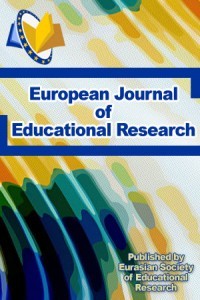Development of a Scale to Measure Educators’ Practice in Teaching Self-Determination
Development of a Scale to Measure Educators’ Practice in Teaching Self-Determination
___
- Abery, B. H., & Stancliffe, R. J. (2003). An ecological theory of self-determination: Theoretical foundations. In M. L. Wehmeyer, B. H. Abery, D. E. Mithaug, & R. J. Stancliffe (Eds.), Theory in self-determination: Foundations for educational practice (pp. 25-42). Springfield, IL: Charles C. Thomas.
- Agran, M., Cavin, M., Wehmeyer, M. L., & Palmer, S. B. (2006). Participation of students with moderate to severe disabilities in the general curriculum: The effects of the self-determination learning model of instruction. Research and Practice for Persons with Severe Disabilities, 31(3), 230-241.
- Cameto, R., Levine, P., Wagner, M., & Marder, C. (2003). The emerging independence of youth with disabilities. In M. Wagner et al. (Eds.), The achievements of youth with disabilities during secondary school (pp. 6.1-6.22). Menlo Park, CA: SRI International.
- Carter, E. W., Lane, K. L., Pierson, M. R., & Glaeser, B. (2006). Self-determination skills and opportunities of transition-age youth with emotional disturbance and learning disabilities. Exceptional Children, 72, 333- 346.
- Denney, S. C., & Daviso, A. W. (2012). Self-determination: A critical component of education. American Secondary Journal, 40(2), 43-51.
- DeVellis, R. F. (2016). Scale development: Theory and applications (4th ed.). London: SAGE.
- Green, S. B., & Salkind, N. J. (2011). Using SPSS for Windows and Macintosh: Analyzing and understanding data (6th ed.). Upper Saddle River, NJ: Prentice Hall.
- Hoffman, A., Field, S., & Sawilowksy, S. (1996). Self-determination assessment battery user’s guide. Detroit, MI: Wayne State University.
- Kelly, J. R., & Shogren, K. A. (2014). The impact of teaching self-determination skills on the on-task and off-task behaviors of students with emotional and behavioral disorders. Journal of Emotional and Behavioral Disorders, 22(1), 27-40.
- Mithaug, D. E., Campeau, P. L., & Wolman, J. M. (2003). Assessing self-determination prospects among students with and without disabilities. In D. E. Mithaug, D. Mithaug, M. Agran, J. Martin, & M. L. Wehmeyer (Eds.), Self-determined learning theory: Construction, verification, and evaluation (pp. 61-76). Mahwah, NJ: Lawrence Erlbaum.
- Nota, L., Ferrari, L., Soresi, S., & Wehmeyer, M. (2007). Self-determination, social abilities and the quality of life of people with intellectual disability. Journal of Intellectual Disability Research, 51, 850-865.
- Palmer, S. B., & Wehmeyer, M. L. (2003). Promoting self-determination in early elementary school: Teaching self-regulated problem-solving and goal-setting skills. Remedial and Special Education, 24, 115- 126.
- Prater, M. A., Redman, A. S., Anderson, D., & Gibb, G. S. (2014). Teaching adolescent students with learning disabilities to self-advocate for accommodations. Intervention in School and Clinic, 49(5), 298-305.
- Rowe, D. A., Mazzotti, V. L., & Sinclair, J. (2015). Strategies for teaching self- determination skills in conjunction with the common core. Intervention in School and Clinic, 50(3), 131-141.
- Shogren, K. A., Wehmeyer, M. L., Palmer, S. B., Soukup, J. H., Little, T. D., Garner, N., & Lawrence, M. (2007). Examining individual and ecological predictors of the self-determination of students with disabilities. Exceptional Children, 73, 488-509.
- Shogren, K. A., Wehmeyer, M. L., Palmer, S. B., Rifenbark, G. G., & Little, T D. (2015). Relationships between self-determination and postschool outcomes for youth with disabilities. The Journal of Special Education, 48(4), 256-267.
- Tabachnick, B. G., & Fidell, L. S. (2006). Using multivariate statistics (5th ed.). Needham Heights, MA: Allyn & Bacon.
- Wagner, M., Newman, L., Cameto, R., Garza, N., & Levine, P. (2005). After high school: A first look at the post-school experiences of youth with disabilities. A report from the National Longitudinal Transition Study-2 (NLTS2). Available from the National Longitudinal Transition Study-2 Website at http://www.nlts2.org/reports/2005_04 /nlts2_report_2005_04 _complete.pdf
- Wehmeyer, M. L. (1999). A functional model of self-determination: Describing development and implementing instruction. Focus on Autism and Other Developmental Disabilities, 14, 53-61.
- Wolman, J. M., Campeau, P. L., DuBois, P. A., Mithaug, D. E., & Stolarski, V. S. (1994). AIR Self-Determination Scale and User Guide. Palo Alto, CA: American Institutes for Research.
- ISSN: 2165-8714
- Başlangıç: 2012
- Yayıncı: Eurasian Society of Educational Research
Guadalupe Elizabeth MORALES-MARTİNEZ, Ernesto Octavio LOPEZ-RAMİREZ, Claudia CASTRO-CAMPOS, Maria Guadalupe VİLLARREAL-TREVİNO, Claudia Jaquelina GONZALES-TRUJİLLO
Salih CAKMAK, Hatice Cansu YİLMAZ, Hacer Damlanur ISİTAN
Mehmet Koray SERİN, Semahat INCİKABİ
M. Sait DİNC, Zubeyde KOCYİGİT
The Impact of Conversations on Fourth Grade Reading Performance - What NAEP Data Explorer Tells?
Development of a Scale to Measure Educators’ Practice in Teaching Self-Determination
Measuring Literary Reading Motivation: Questionnaires Design and Pilot Testing
Maria Guadalupe VİLLARREAL-TREVİÑO, Ricardo Jesus VİLLARREAL-LOZANO, Guadalupe Elizabeth MORALES-MARTİNEZ, Ernesto Octavio LOPEZ-RAMİREZ, Norma Esthela FLORES-MORENO
